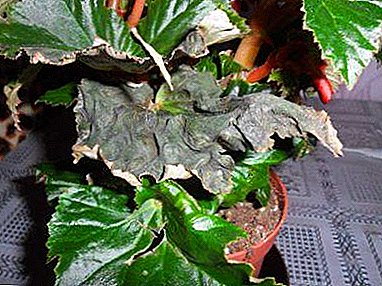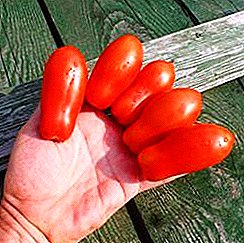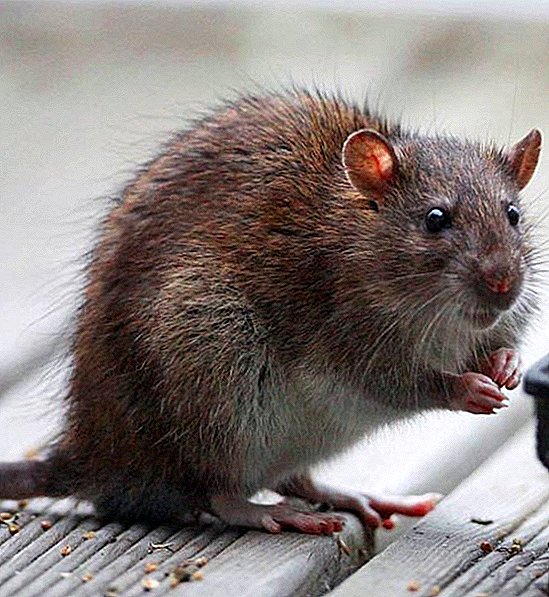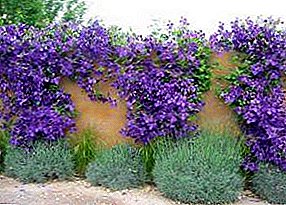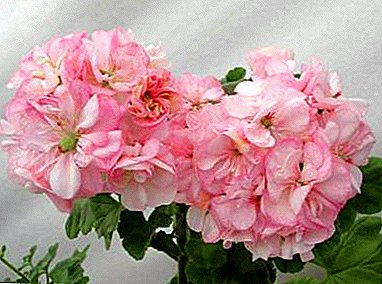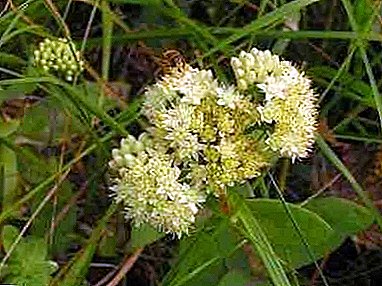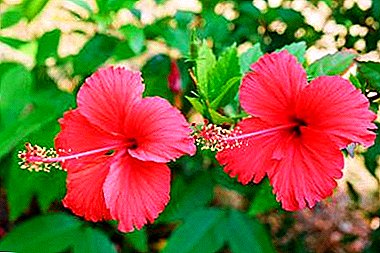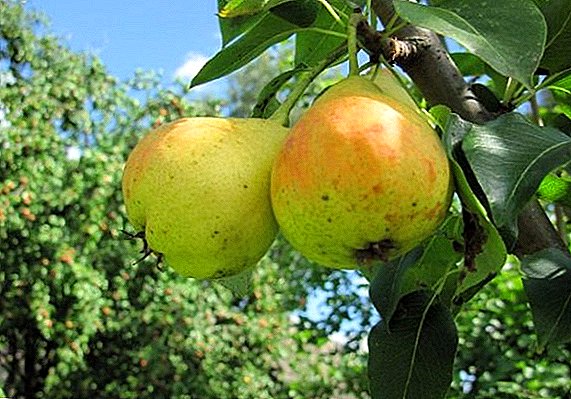 Among the summer varieties of pears, the Nursery pear is considered the earliest, which is also notable for its particularly sweet taste and good yield. For this reason, below we will examine in detail the features of growing the Nursery pear, so that each gardener can decorate her own plot.
Among the summer varieties of pears, the Nursery pear is considered the earliest, which is also notable for its particularly sweet taste and good yield. For this reason, below we will examine in detail the features of growing the Nursery pear, so that each gardener can decorate her own plot.
History of creating varieties of pears for children
The first pear seedlings of the Nursery variety were obtained in the All-Russian Nursery of Moscow, where breeders Yu. A. Petrov and N. V. Efimova worked on it. To obtain this self-fruited pear, an interspecific hybrid at number eight and a fairly well-known variety of Dyushesa summer ripening were crossed. Due to the accelerated early ripening and the pleasant taste of large fruits, this variety has become widespread and is now actively grown in the central part of Russia and throughout Ukraine.
Characteristics of pear varieties for children
 According to the external characteristics, it is not so easy to find the Children's Pear variety, since both the tree and the external shape of the fruit are in many ways similar to other summer varieties, especially with its relative Dushes. But nevertheless on some distinctive characteristics it is worth stopping attention.
According to the external characteristics, it is not so easy to find the Children's Pear variety, since both the tree and the external shape of the fruit are in many ways similar to other summer varieties, especially with its relative Dushes. But nevertheless on some distinctive characteristics it is worth stopping attention.
Tree description
Children's pear is a tall variety, since the height of the tree of this variety reaches about 3-4 meters. Nursery Pear is distinguished by the early formation of the crown, which in an adult tree has a pyramidal shape. There are not many branches in the crown, but they are very powerful and thick. On the branches there is a huge amount of ringworms, on which not less abundant fruiting is formed.
The shoots of the tree almost all have a smooth shape, stretch up. Over time, they become very thick, have a light brown bark. Since spring, branches are abundantly covered with dark green leaves. The shape of the leaves is oval, they have a smooth surface and finely edged edges.
Did you know? The great advantage of the Children's Pear tree is the longevity of the tree, which retains its ability to produce generous yields for more than 20 years.
Fruit Description
 Children's Pear has a high yield, which in favorable years can reach the figure of 50-60 tons with garden plantations of 1 hectare. Perhaps this is not only due to the abundant formation of fruits, but also due to the mass of each pear, which can weigh 60-80 g each.
Children's Pear has a high yield, which in favorable years can reach the figure of 50-60 tons with garden plantations of 1 hectare. Perhaps this is not only due to the abundant formation of fruits, but also due to the mass of each pear, which can weigh 60-80 g each.
Also the following characteristics are inherent in the fruit of the pear variety for children:
- short pear-shaped form with elevated pearls;
- rough surface of the skin;
- color light yellow with a pink blush;
- the stem is medium in length and thickness;
- medium sized calyx;
- seeds are small, have a brown color;
- axial cavity is missing.
The pulp of this pear has a cream shade, and also differs in excellent juiciness and high sweetness. Thanks to the taste characteristics this variety is appreciated. In addition, as we have already mentioned, among the summer varieties, the Nursery pear has the earliest maturity of fruits that become suitable for human consumption as early as July and continue to ripen until about mid-August. Such non-simultaneous ripening makes the described variety of pears more suitable for home and not mass cultivation.
Ripe pears are suitable for both fresh use and for all types of processing. They have a small shelf life, due to the high content of sugars in the pulp. However, in the refrigerator they will keep a fresh look for up to one month.
 Naturally, each gardener is interested in the question whether a pollinator is necessary for a nursery pear. Unfortunately, This pear variety is only partially self-pollinating, therefore the presence of bees is very important for obtaining a bountiful harvest. If you bought a one-year-old tree in the nursery, then the first flowering on it will come only after 4-5 years. However, after this the yields will be consistently good.
Naturally, each gardener is interested in the question whether a pollinator is necessary for a nursery pear. Unfortunately, This pear variety is only partially self-pollinating, therefore the presence of bees is very important for obtaining a bountiful harvest. If you bought a one-year-old tree in the nursery, then the first flowering on it will come only after 4-5 years. However, after this the yields will be consistently good.
Advantages and disadvantages of the variety
Many positive qualities in the Nursery pear are already clear from her description, but in order to finally be convinced of the necessity of planting this variety in our garden, let us draw your attention to its advantages in comparison with other pear varieties:
- excellent resistance to environmental instability;
- high yields of good tasty pears;
- excellent taste characteristics of the fruit;
- early ripening.
However, there are pears Nursery and its shortcomings. If we compare its fruits with other varieties, then they can rather be called medium, although with good care, the size of the fruit can increase significantly. In addition, trees of this class require regular maintenance in the form of formative pruning. Due to pruning, it is also recommended to reduce the height of the tree, and it will give more of its strength to the formation of fruits.
Some nuances of planting pear nursery
Pear Children in planting and care is not at all whimsical, although some of the nuances of its planting is still worth knowing. After all, to get a good fruit tree, it must first be planted and grown to a fruitful period.
Landing dates and site selection
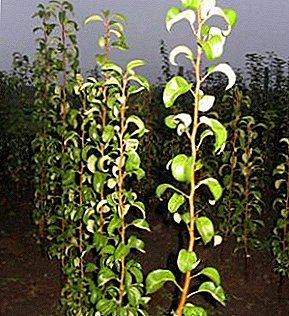 Sowing pears of the Children's variety can be planted either in early spring, before the movement of juices in the tree, or in late autumn, when the sap flow has already stopped. However, many gardeners insist on the fact that pear better planted in the autumn, at the end of September. Garden trees are almost always located on the southern part of the site, although they can also take a place in the east or west. It is better if the planting of the Junior pear will be carried out on an elevation or slope, since when planting in low ground, the groundwater may rise too high to the roots of the tree, as a result of which they may rot (in the adult pear, the Junior pear may go deep into 7 meters).
Sowing pears of the Children's variety can be planted either in early spring, before the movement of juices in the tree, or in late autumn, when the sap flow has already stopped. However, many gardeners insist on the fact that pear better planted in the autumn, at the end of September. Garden trees are almost always located on the southern part of the site, although they can also take a place in the east or west. It is better if the planting of the Junior pear will be carried out on an elevation or slope, since when planting in low ground, the groundwater may rise too high to the roots of the tree, as a result of which they may rot (in the adult pear, the Junior pear may go deep into 7 meters).
Particular attention should be paid to the soil: you should not plant this pear in a swampy area, on clay soil or sand, as it may still not settle down, but you will not even dream of a good harvest. For this variety, the preferred soil types are:
- gray forest with loamy subsoil;
- black soil
Important! If you wish, of course, you can independently make the soil on your plot more suitable for planting and growing pears of the Nursery variety. For this purpose, you can either mix it with fertile black soil, or remove most of the natural soil and fill it in its place more fertile. However, please note that it will be necessary to fertilize such soil as often as possible, since in the process of growth the pear will require more and more nutrients, therefore the artificially introduced soil will quickly become impoverished.
Preparatory procedures before landing
 If you want to plant a variety of pears for children, then it is much more rational to do this in the fall, which will allow the tree to “harden” and become more resistant to diseases and low temperatures. The only drawback of such a landing is the need to prepare a thorough shelter for a seedling, which in winter can be attacked by rodents and may suffer from low temperatures. But since such difficulties are fully justified, it is still necessary to tune in precisely to such a landing, in preparation for which it is necessary:
If you want to plant a variety of pears for children, then it is much more rational to do this in the fall, which will allow the tree to “harden” and become more resistant to diseases and low temperatures. The only drawback of such a landing is the need to prepare a thorough shelter for a seedling, which in winter can be attacked by rodents and may suffer from low temperatures. But since such difficulties are fully justified, it is still necessary to tune in precisely to such a landing, in preparation for which it is necessary:
- Purchase a two-year-old sapling, choosing the copy that does not have dry or rotted roots. There should also be no damage on the seedling trunk.
- The day before planting, the seedling is recommended to be dipped for 12 hours in warm water, which will allow the roots to recover and prepare for adaptation at the new growth site.
- The pit is prepared in advance - 3-4 weeks before planting the seedling. If you are preparing for spring planting, then the preparation of the pit should be started in the fall, which will allow the soil to sink as well as possible.
- It is necessary to prepare a landing hole taking into account soil type. If it is suitable for a pear, the pit may slightly exceed the volume of the roots in size. However, if there is a need for additional fertilization, the dimensions of the pit should be 0.7 x 0.7 m wide and 1 meter deep.
- Immediately hammer a stake into the bottom of the pit so that its top protrudes at least 0.5 meters above the soil surface. To him we will tie a young seedling after planting.
- To the soil that you got from the pit, keep about 30 kg of compost (you can replace with peat or manure, which you have already managed to perepret), 1 kg of superphosphate, 0.1 kg of potassium chloride. Pour half of the mixture obtained at the bottom of the pit and tamp down, and pour the rest in a slide near the peg.
Stepwise landing process
To ensure maximum survival of the seedling, before planting, prepare a clay mash in which it will be necessary to lower the pear roots. The roots of the sapling so moistened in this way are placed on the north side of the stake driven into the bottom of the pit and spread over the mound, while trying to give them a natural position. After this, the roots are covered with fertile soil. To prevent air accumulation in the pit and between the roots, the seedling needs to be slightly shaken, ensuring the natural distribution of the soil. It is also important to trample the soil, heading in their movements from the trunk of the seedling to the edges of the pit. Consider also that the root neck at this stage should not protrude above the surface, but when you pour the seedling with 2-3 buckets of water and the soil settles, it should protrude by 4-5 cm. At the end of the planting, the Pear pear tree seedling must necessarily mulch a circle. For this purpose, you can use peat, sawdust and humus, creating a layer of mulch of 5-10 cm. Do not forget to tie a young pear to the stake.
It is also important to trample the soil, heading in their movements from the trunk of the seedling to the edges of the pit. Consider also that the root neck at this stage should not protrude above the surface, but when you pour the seedling with 2-3 buckets of water and the soil settles, it should protrude by 4-5 cm. At the end of the planting, the Pear pear tree seedling must necessarily mulch a circle. For this purpose, you can use peat, sawdust and humus, creating a layer of mulch of 5-10 cm. Do not forget to tie a young pear to the stake.
If the landing is carried out in the spring, then all the above nuances are repeated. The only difference is that the seedling does not need such a layer of mulch (you can do without it). At the same time it is necessary to make a hillock around the tree circle, which will prevent the spreading of moisture, and regularly water the tree with 2-3 buckets of water.
Some tips for the care of Pear Baby
Most of the attention to themselves requires a young tree, because it only gets stronger and needs a large supply of nutrients for active growth. Consider all the features of care.
How to water the pears
 If we are talking about a young sapling, then since spring it will need regular watering. However, this does not mean that the tree literally needs to be flooded with water. Moisture should be introduced as the soil dries out, and if the spring is rainy enough and the tree shows all signs of revival, then watering can be avoided. It is worth returning to them in the summer, when in hot weather it will not be superfluous to deposit 2 buckets of clean water every day for each tree. In the autumn, the amount of watering is also reduced, which will allow the seedling to quickly stop the flow of juices and prepare for wintering.
If we are talking about a young sapling, then since spring it will need regular watering. However, this does not mean that the tree literally needs to be flooded with water. Moisture should be introduced as the soil dries out, and if the spring is rainy enough and the tree shows all signs of revival, then watering can be avoided. It is worth returning to them in the summer, when in hot weather it will not be superfluous to deposit 2 buckets of clean water every day for each tree. In the autumn, the amount of watering is also reduced, which will allow the seedling to quickly stop the flow of juices and prepare for wintering.
What and when to fertilize pears
Top dressing of a young pear is necessary regularly, therefore it is necessary to carry out them throughout the entire period of vegetation. Consider only that in the first two years the pear will not need any additional feeding at all, since during planting you have brought in a sufficient amount of nutrients. But after this period a year will have to spend about five supplements:
- Until sap flow begins, the tree is sprayed with a solution of urea. If it was not possible to carry it out, then nitrogen is introduced under the stem, for which a similar solution from urea, nitrate or from chicken manure can be used.
- In May, when flowering is completed, a green fertilizer is applied under the digging 10 cm deep, which can be replaced with a solution of Nitroammofoski in a concentration of 1: 200. 3 buckets of such a solution will be required for one tree.
- The second feeding with nitrogen is carried out at the end of June, but it must be carried out by foliar spraying. It is repeated in July.
- At the end of July, it will not be superfluous to feed the pear with phosphorus and potassium. These fertilizers are applied in the form of solutions under the root.
- In mid-September, the last dressing is carried out, which consists in another spraying of the tree with urea.
How to trim a pear
In order to prune this garden tree correctly, you need to know the following rules:
- The best time for pruning is spring, while the juice has not yet gone on the tree, and the air temperature does not fall below -8 ° C.
- In summer, pruning is also permissible, but it is carried out in case of emergency - when the crown of the tree is so thick that it does not allow the fruit to ripen evenly.
- If it is necessary to pinch one of the upper shoots of a tree, then this is also done in summer, in June.
- In the fall, pruning is carried out only if it is necessary to remove damaged or diseased branches. It is necessary to do this long before the frost, since the cut area will become very sensitive to cold.

Important! In winter, pruning pears are unacceptable, since such a procedure can lead to the death of the tree.The first pruning can be done in the first year of growth of the tree. It is done in order to leave only skeletal branches in the crown and allow them to form as thick as possible. Also in the first year it is recommended to shorten the center conductor, removing a fourth of its length. In the second year of pear growth, its conductor will again have to be shortened by 25 cm, continue to form the crown, and also shorten the length of the skeletal branches. Keep in mind that, based on the length of the branches left, the crown of the tree should have an attractive pyramidal shape.
As for trimming old wood, it often involves the removal of individual branches, which will lighten and rejuvenate the crown. At the same time, really extra branches should be removed, which, moreover, are weaker and less productive. 
How to protect a pear from diseases and pests
All varieties of pears are susceptible to a huge number of diseases, to save from which a young tree in a large garden is almost impossible. Only prophylactically processing, which even early-spring spraying of trees with urea can be, can help in this. If you delayed this issue and the first swollen buds have already appeared on the tree, then instead of urea you will have to use special preparations (urea can burn young kidneys):
- "Fitoverm";
- "Agravertine";
- "Akarin";
- "Iskra-bio".
Did you know? It is better not to plant pears in the same garden where rowan grows. This is due to the fact that mountain ash and pear are affected by the same pests, and they are characterized by the same diseases. Therefore, a young pear tree will be extremely difficult to protect from diseases.
 It is also worth mentioning that in winter, pears are attacked by pests that can completely tear down the entire layer of bark from the trunk. In order to prevent this, it is recommended to wrap the trunks from the ground and to a height of up to a meter with thick paper or cloth, after soaking them in a special tool that can scare off rodents. In addition to this, it is important to throw in the maximum amount of snow on the trunk circle.
It is also worth mentioning that in winter, pears are attacked by pests that can completely tear down the entire layer of bark from the trunk. In order to prevent this, it is recommended to wrap the trunks from the ground and to a height of up to a meter with thick paper or cloth, after soaking them in a special tool that can scare off rodents. In addition to this, it is important to throw in the maximum amount of snow on the trunk circle.Protecting young trees from the winter cold
Children's frost resistance is very high, so an adult tree can easily winter in the middle climatic zone. But here the young seedlings, which were planted only in spring or autumn, will require mandatory shelter. Before the arrival of cold weather, they should definitely be tied as tightly as possible with a fresh spruce branch so that the needles on it are directed downwards. On top of this design is imposed thick burlap. Such a shelter together with a thick layer of mulch will reliably protect the nursery pear seedling from frost and rodents.
Another danger for a young tree in the winter is the high probability of branches breaking under the weight of snow. In order to avoid this, young branches are recommended to be pulled with a string to the trunk and tied up in this way until spring. If the tree is an adult, then you will have to shake off the snow manually. We hope that the information presented made you fall in love with this unusually juicy and sweet pear variety Nursery, which you will soon be settling in your garden. If you provide the seedling with the right care, then after 4-5 years you can try your own pears.



